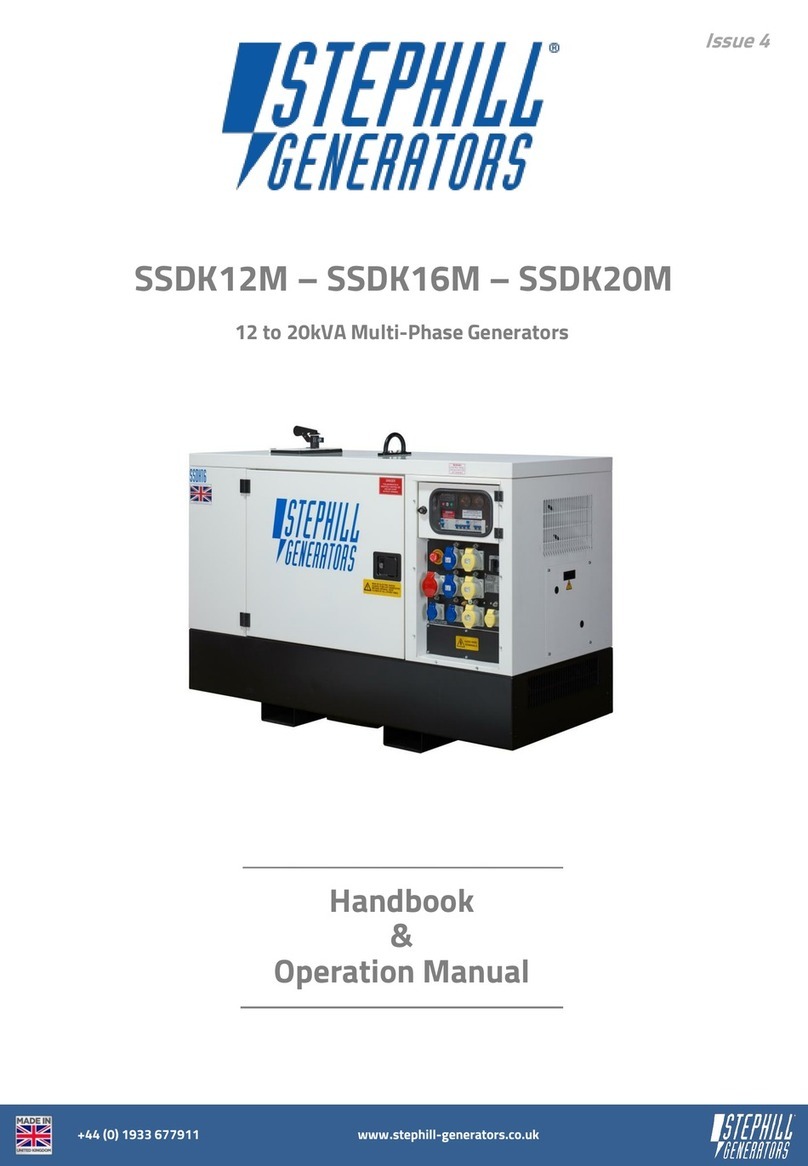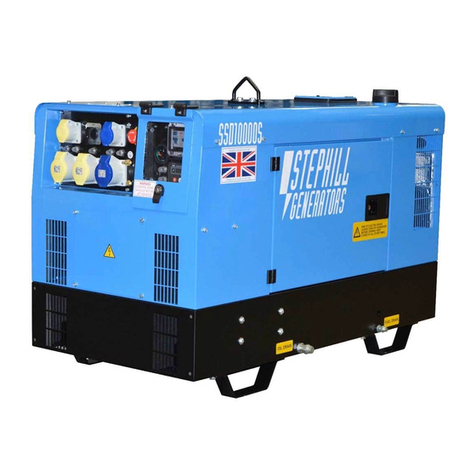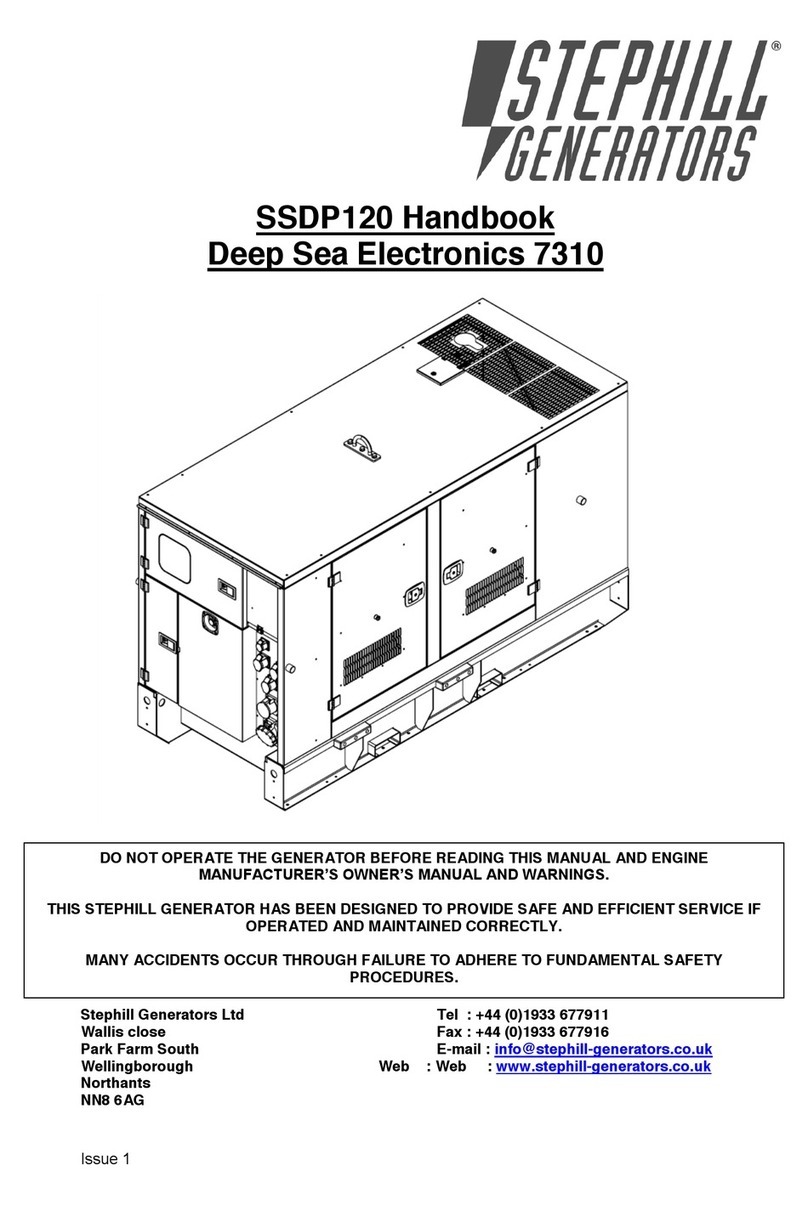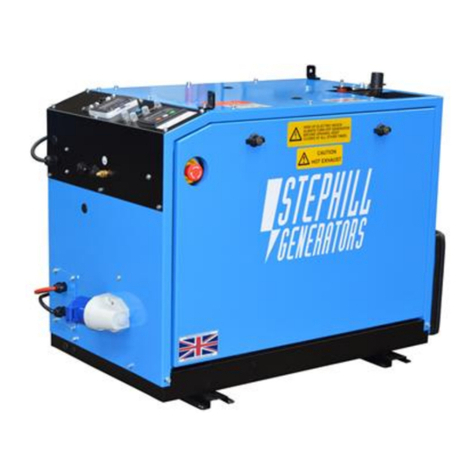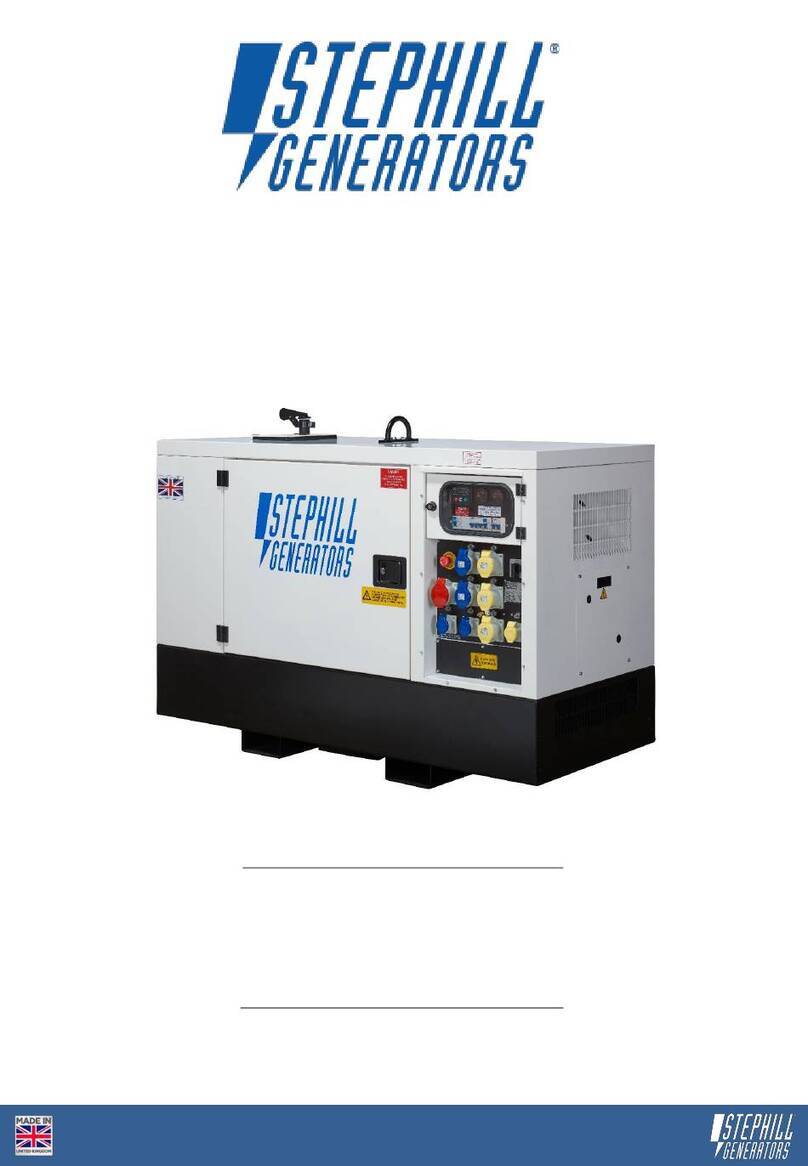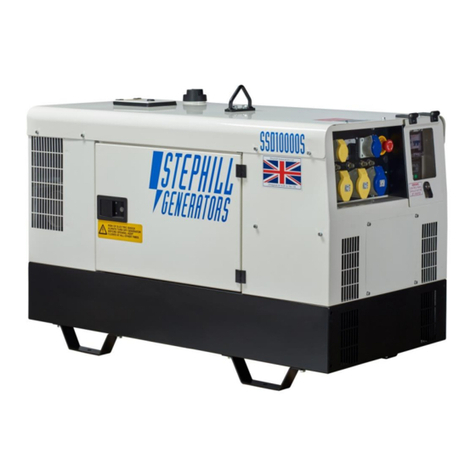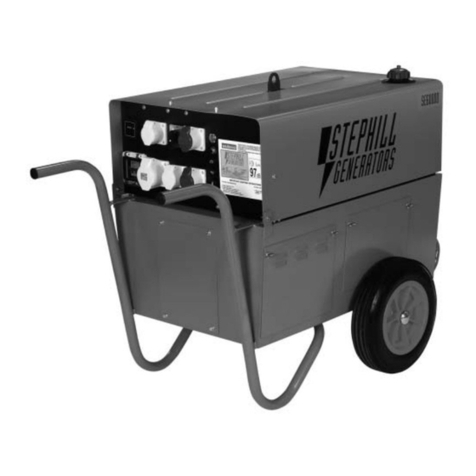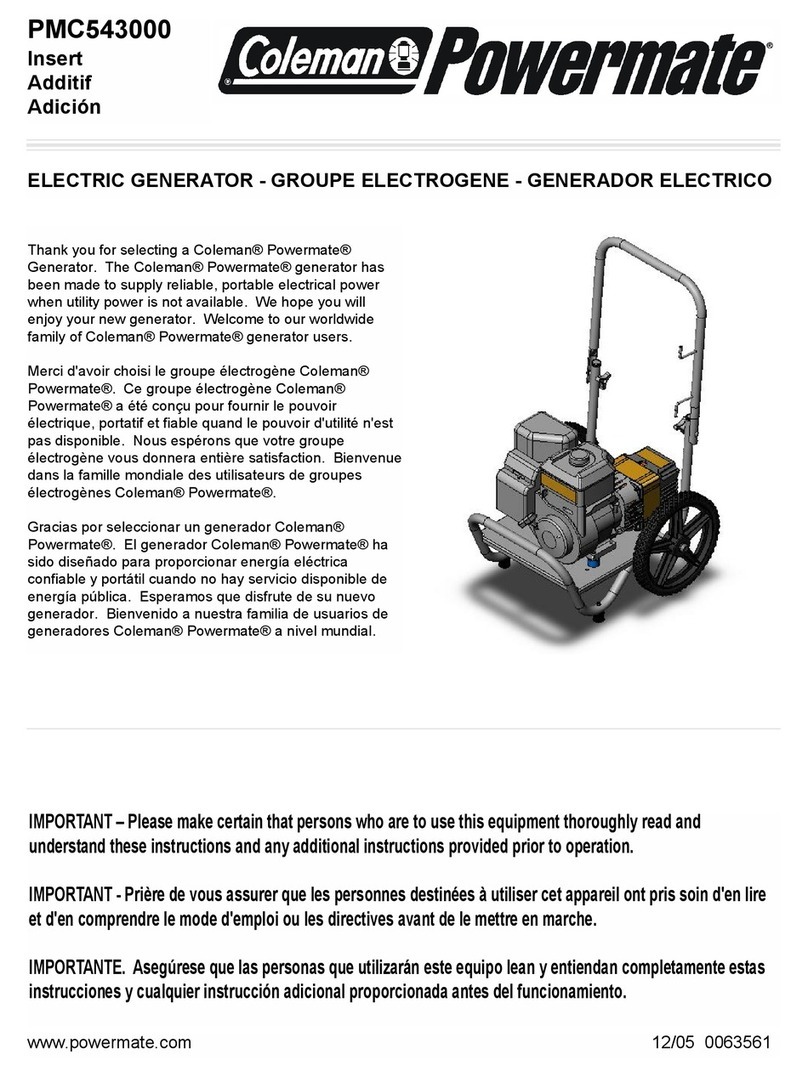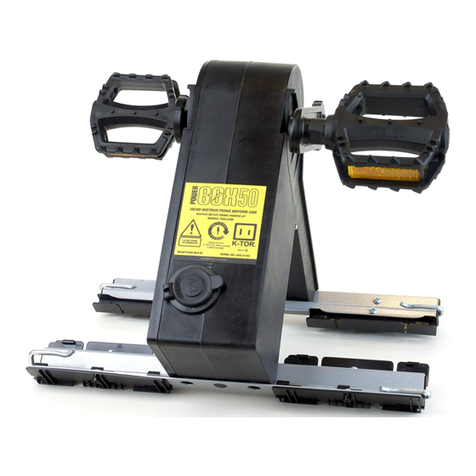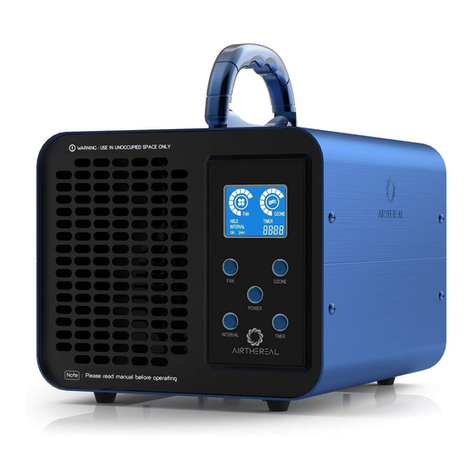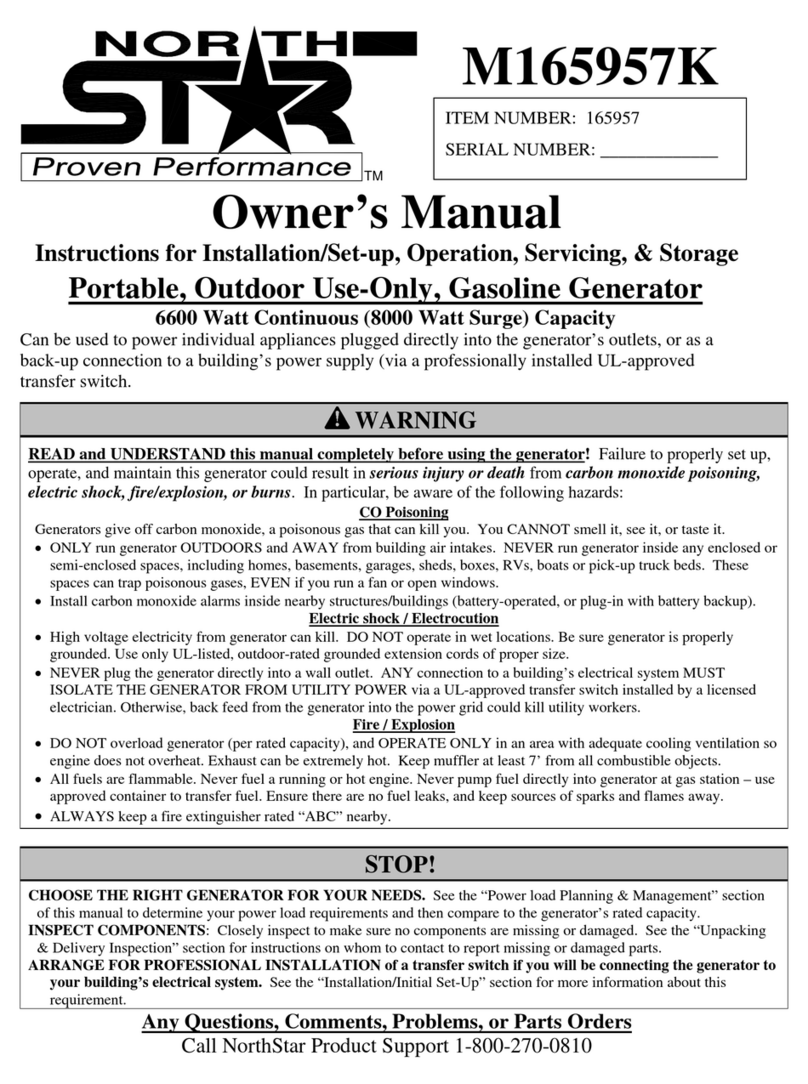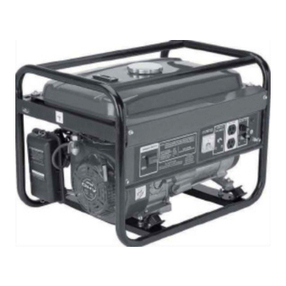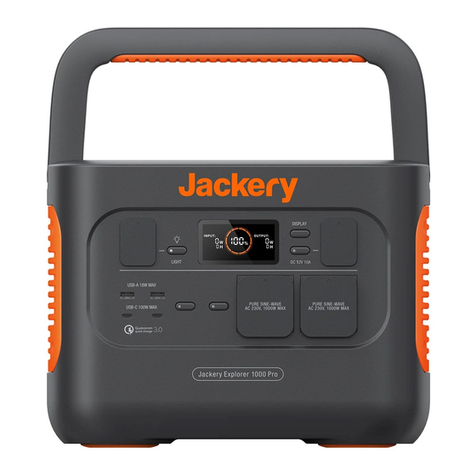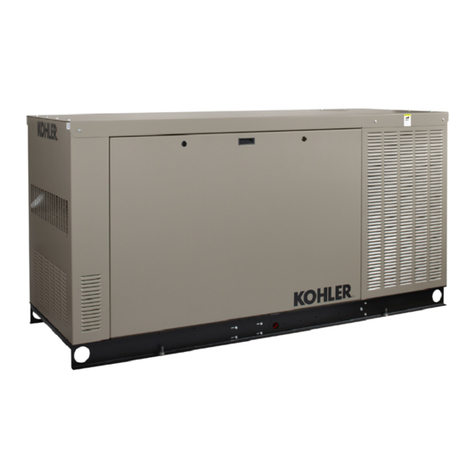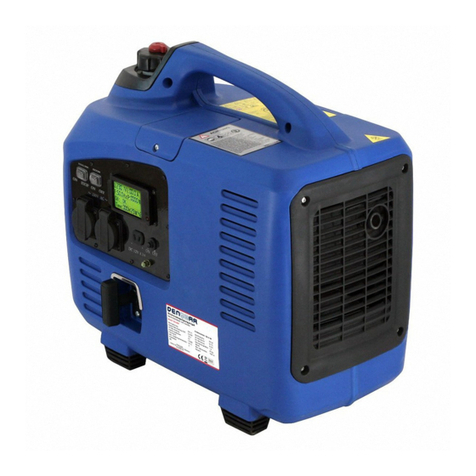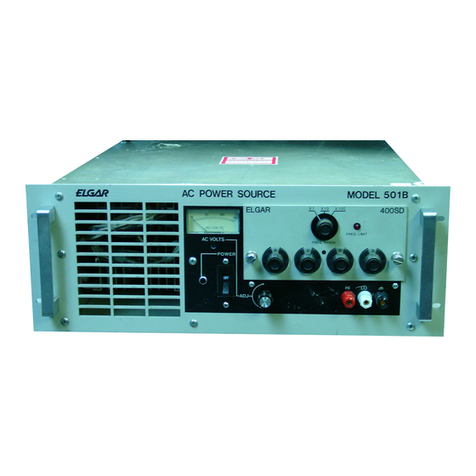Stephill SSDY36V User manual

Issue 1
SSDY36V –SSDY40V –SSDY50V
+44 (0) 1933 677911 www.stephill-generators.co.uk
Handbook
&
Operation Manual
1500rpm Diesel Stage V Generators

SSDY36-50V
3 Introduction
14 Operating Instructions
14 Pre-starts Checks
3 Warranty Statement 14 Check Battery Isolator Key & Location
15 Check Oil Level - How to
3 Amendments 16 Adding Engine Oil
16 Check Coolant Level
4 Identification 17 Check Fuel Level & Fuel Pump Prime
17 Control Panel Checks
5 Specification 18 Starting the Generator - Manual Start
5 AC Output Protection 18 Applying Load
6 AC Output Earthing Method 18 Stopping the Generator - Manual Stop
6 Running Hours 18 Emergency Stop
6 Engine 19 Remote Start/Stop - 2-wire
6 AC Alternator
7 Dimensions & Weights
7-9 Control Panel Identification
20 Long Term Storage
10 Generator Safety
10 Warning Signage
20 DSE 7310 Control Module - Overview
11 Personal Safety
20 DSE 7310 MK3 Front Panel Description
11 Auxiliary Power 21 DSE 7310 Operation
12 Operating Environment 21 Button Description
12 Temperature Range 22 Generator Locked Out
12 Reference Relative Humidity 23 Manual Start
12 Reference Barometric Pressure 23 Starting Sequence & Status Display
12 Flammable Environment 23 Viewing the Status Pages
12 Saline Environment 23 Generator AC Output Screens
24 Generator AC Voltage
12 Safety Considerations 25 Generator Current (amps)
12 General UK & EU
25 Generator Frequency - Hz
13 Fuel 26 Engine Instruments
13 Lubricating Oil 27 AUTO MODE - Start/Stop Operation
13 Bunded Fuel Tank 27 Waiting in AUTO MODE
13 Safe Lifting 28 Alarms - Triggered Alarms
13 Earth Connections 28 Event Log
13 Fumes 29 Generator Fuel Level
14 Noise
14 Battery Acid cont.
14 Fire
14 Hot Parts
Contents
19 2-wire Remote and ATS Auto
Start/Stop Connection Location
19 Hardwire Terminals - Connection &
Location

SSDY36-50V
29 External Fuel Source
29 Fuel Diverter Valve
30 External Fuel
30 Service and Maintenance 45 Wiring Diagrams
30 Diesel Particulate Filter (DPF) 45 Engine DC - SW11079
31 DPF Regen Required 46 SSDY36V 230V - SW12129
31 Performing a DPF Regen 47 SSDY40V 400V - SW30105
32 Pre-service 48 SSDY50V 400V - SW30109
32 Engine Service
32 Resetting the Maintenance Service Alarm
32 Oil System Service
33 Oil System Location
33 Oil System Service Procedure
33 Alternator Service
34 Road Tow Trailers
34 Trailer Information
34 Safety Precautions
34 Wheels
34 Number Plate
35 Hitch Type
35 Pre-towing/Hitch Up
35 Hitching Method
36 Service Brake
36 Reversing
36 Fault Finding
36 Monitoring Systems
36 Before Fault Finding
37 Generator Not Starting
37 Generator Starts & Runs
37 Generator Runs, Stops & Shuts Down
38 Fault Finding - DSE 7310 Engine Shutdown Alarms DC
39 Fault Finding - DSE 7310 Generator Shutdown Alarms AC
41 Fault Finding - No AC Output
42 Fault Finding - Fuel Gauge Not Operating
42 Spares
42 Yanmar Consumable Service Spares
42 Control Panel - AC Components
43 Control Panel - DC Components
43 General Spares
43 Engine Accessories
43 Exhaust System Spares
44 Generator Not Starting Flow
Chart

SSDY36-50V 3
© Stephill Generators Ltd.
All rights reserved.
Operation with incorrect fuel, lubricating oil or coolant.
Improper repair or use of parts not supplied or approved by Stephill Generators Ltd.
Lack of, or incorrect maintenance.
Issue Date By
Introduction
Warranty Statement
This document has been produced for the owner/user of a Stephill generator. Inside this manual you will find
important safety, operating, maintenance and fault finding information.
The information contained within this manual is based upon the current data available before print. Due to
constant improvements on our products some information contained within this manual may change
without warning. Therefore Stephill Generators Ltd reserve the right to alter specifications as and when
situations demand without warning or obligation.
No part of this material may be reproduced in any form by any means without the written permission of
Stephill Generators Ltd.
All equipment supplied by Stephill Generators Ltd carries a warranty of 12 months from date of despatch.
During the warranty period, should the plant fail due to faulty design, materials or workmanship by Stephill
Generators Ltd or it’s sub-contractors, we undertake to rectify the fault. Stephill Generators Ltd will accept
no responsibility whatsoever for equipment that has failed due to;
Fair wear and tear, misuse, negligence, accidental damage, improper storage and incorrect starting / warm-
up / run-in or shutdown.
No warranty claim will be considered by Stephill Generators Ltd unless any defective parts are available for
inspection by us, or our nominees, to determine the reason or cause of failure, and Stephill Generators Ltd is
given the option of repair or replacement.
Stephill Generators Ltd are not responsible for incidental or consequential damages, downtime, or other
costs due to warrantable failure, and unauthorised alterations made to any product supplied by Stephill
Generators Ltd.
Amendments
Amendment

SSDY36-50V 4
Example
Fig.1
1Generator model type
2Unique serial number
3CE & UKCA marks. Directives listed on the relevant Declaration of Conformity
Total fuel tank capacity
Generator performance class
MGW - Mass Gross Weight(s)
5Rated output frequency
6Power factor
7Number of phases
8AC voltage output(s)
9Continuous prime rated power, kVA & kW
10 Standby rated power, kVA & kW
11 Relevant maximum current ratings, amps
Each Stephill generator will have a Serial/Data plate fitted to the set. In most cases this can be found on the
control panel door of a SSDY-Range generator. Below is an example of the Serial/Data plate - Fig.1
Identification
Item No.
Description
4
11
10
3
1
2
4
5
9
8
7
6

SSDY36-50V 5
The standard configuration(s) consist of the following:
SSDY40-50V
3 pole MCB's overload/short circuit protection for each 400V 3Ph socket outlet (if applicable).
Double pole RCBO's 30mA overload/short circuit and earth leakage protection for each 230V socket outlets.
SSDY36V
63A double pole MCB overload/short circuit protection for the 63A 230V socket outlet.
43.4kVA / 34.7kW
Specification
Model Type
Prime Power (PRP) - 3Ph
SSDY40V
34.6kVA / 27.7kW
SSDY50V
47.5kVA / 38.0kW
The SSDY40V & SSDY50V are configured as three phase sets with single phase spurs from each phase. The
SSDY36V is a 230V single phase only set.
Standby Power - 1Ph
Prime Power (PRP) - 1Ph
36.0kVA / 29.0kW
32.0kVA / 26.0kW
SSDY36V
50.0 Hz
230V AC
1 Ph
90
50.0 Hz
90
65
3 Ph / 1 Ph
Voltage
Model Type
65
310 Litres
Voltage
(PRP) Prime Power: Applicable for supplying power to electrical load for unlimited hours in accordance with
ISO 8528-1 under the agreed operating conditions with the maintenance intervals and procedures being
carried out as prescribed by the manufacturers.
Frequency
Standby Power - 3Ph
38.5kVA / 30.8kW
Frequency
Fuel Tank Capacity
Standby Power: An approximate overload of 10% is allowed for 1 hour in 12. This is typically used for
regulation purposes and small unexpected loading.
Main MCCB overload/short circuit protection combined with a shunt trip operated by a variable earth
leakage relay. This is the main protection for all socket outlets and the hardwire terminals.
Double pole RCBO's 30mA overload/short circuit and earth leakage protection for all other 230V socket
outlets.
Main MCCB overload/short circuit protection combined with a shunt trip operated by a variable earth
leakage relay. This is the main protection for all socket outlets and the hardwire terminals.
Phase
LWA
dBA @ 7M
Phase
LWA
dBA @ 7M
310 Litres
400V / 230V AC
Fuel Tank Capacity
AC Output Protection

SSDY36-50V 6
Note
MCCB = Moulded Case Circuit Breaker
MCB = Miniature Circuit Breaker
RCD = Residual Current Device
RCBO = MCB & RCD combined
All are suitably rated for the generator model type.
400V 3Ph - Neutral (star point) bonded to earth.
230V 1Ph - Neutral bonded to earth.
Net Engine Power
Aspiration
Net Engine Power
3.3 Litres
35.2 kW
AC Output Earthing Method
Running Hours
SSDY40V / SSDY36V
Aspiration
Natural
Turbo
Displacement
Emissions Certification
Water Cooled
SSDY50V
75% Load
100% Load
DER 3Ø Electronic +/- 1%
Meccalte ECP32-2S4 C
AVR
Rpm
1500
Rpm
SSDY40V / SSDY36V
Yanmar 4TNV98CT-IYE
SSDY50V
EU Stage V Compliant
1500
SSDY50V
SSDY40V
SSDY36V
Type
Model Type
39 hours @ 7.1 Litres per hour
112 hours @ 2.5 Litres per hour
72 hours @ 3.9 Litres per hour
52 hours @ 5.4 Litres per hour
39 hours @ 7.1 Litres per hour
4
Meccalte ECP32-1M
AC Alternator
Type
Emissions Certification
Cylinders
Engine
Type
Yanmar 4TNV98C-IYE
EU Stage V Compliant
Cylinders
4
Cooling
Water Cooled
Displacement
3.3 Litres
25% Load
43.7 kWm
112 hours @ 2.5 Litres per hour
72 hours @ 3.9 Litres per hour
52 hours @ 5.4 Litres per hour
Cooling
50% Load

SSDY36-50V 7
Skid Mounted
Weight - Dry
Weight - Wet
Road Trailer
Weight - Dry
Weight - Wet
Skid Mounted
Weight - Dry
Weight - Wet
Road Trailer
Weight - Dry
Weight - Wet
Below in Fig.2, is a typical example of the control end found on many of the Stephill Y-Range generators.
Fig.2
The control panel end is made up of engine and generator controls (DC) and the generator output (AC).
Control Panel End Identification
1190 KG
1448 KG
L 4100mm W 1620mm H 2020mm
1420 KG
L 2150mm W 1050mm H 1580mm
1468 KG
L 4100mm W 1620mm H 2020mm
1440 KG
1706 KG
SSDY40V
SSDY50V
1218 KG
1476 KG
1448 KG
L 4100mm W 1620mm H 2020mm
SSDY36V
L 2150mm W 1050mm H 1580mm
L 2150mm W 1050mm H 1580mm
1680 KG
Dimensions & Weights
1210 KG
1658 KG
Main Control
Panel
Socket Panel
Hard Wire
Main Breaker
MCCB
Socket Protection

SSDY36-50V 8
Main Control Panel
Fig.3
Item No.
1DSE 7310 Control Module
2Engine Regen Indicator LED (Amber)
3RCD Bypass switch and LED (Red)
4Variable Earth Leakage Relay (ELR)
Socket Panel & Protection
SSDY40V & SSDY50V
Fig.4 Fig.5
Description
1
2
3
4
6
7
8
9
10
11
1
2
3
4
5

SSDY36-50V 9
Item No. Item No.
116A 30mA RCBO - L3 616A 230V Socket - L3
232A 30mA RCBO - L2 732A 230V Socket - L2
332A 30mA RCBO - L1 832A 230V Socket - L1
432A 3 Pole MCB 932A 400V Socket
563A 3 Pole MCB (SSDY50V only) 10 63A 400V Socket
11 Brass Earth Stud
Socket Panel & Protection
SSDY36V
Fig.6
Item No. Item No.
116A 30mA RCBO 516A 230V Socket
232A 30mA RCBO 632A 230V Socket
332A 30mA RCBO 732A 230V Socket
463A 2 Pole MCB 863A 230V Socket
9Brass Earth Stud
Description
Description
Description
Description
Fig.7
5
6
7
8
9
1
2
3
4

SSDY36-50V 10
Warning Signage
b) Located on both main canopy doors.
e) Located on the control panel door.
d) Located on top of the canopy near the
coolant filler flap for the radiator access.
* Correct antifreeze type at the time of
print - check with actual label on the
generator.
a) Located on the control panel door.
Before using this equipment and to avoid personal injury, all warnings shown on the machine should be
observed. The warning signage should be checked for legibility and any that have become damaged should
be replaced.
Carefully read and understand the instructions provided. If there is anything you do not understand DO NOT
attempt to use this generator. Contact your supplier for advice.
Generator Safety
c) Located on the engine end access door
and near the exhaust outlet on the roof.
WARNING
BEFORE STARTING
●READ HANDBOOK AND SAFETY ADVICE
●CHECK OIL LEVEL
●DO NOT ADJUST ENGINE SPEED
WITHOUT SUITABLE TEST EQUIPMENT
a)
b)
c)
d)
e)
f)

SSDY36-50V 11
f) Located on the control panel door.
g) Located on the control panel door.
h) Located on the hardwire door and plate.
• Do not climb on the generator - dents may cause overheating of the acoustic lining.
• Keep well clear of any moving parts on the generator at all times.
• Keep children and pets away from the generator and operating area.
• Test safety features often, emergency stop button and RCD (residual current device).
• Keep the generator canopy doors shut while running and locked if possible.
Do not remove covers and attempt to work on the generator while the engine is running.
Check the rating and electrical safety of the load before connecting the generator.
Equipment should never be connected that in total exceeds the specified rating of the generator.
Personal Safety
The electricity produced by an engine driven generator is very similar to mains AC electricity and should be
treated accordingly.
• Do not cover the generator as this can obstruct air inlet and outlets on the canopy which can cause the
generator to overheat and cause permanent damage..
Auxiliary Power
Installation of the generator as a standby or secondary power source should only be undertaken by a fully
qualified electrician using the appropriate means of isolation from the mains supply. Installation must
comply with all applicable laws, electrical codes and wiring regulations.
f)
g)
h)

SSDY36-50V 12
Stephill generators must not be used in a flammable environment.
Operation of the machine in a saline environment will require additional corrosion protection.
2008 No. 1597 The Supply of Machinery (Safety) Regulations 2008
2016 No. 1091 The Electromagnetic Compatibility Regulations 2016
2001 No. 1701 Noise Emission in the Environment by Equipment for use Outdoors Regulations 2001
2012 No. 3032
2006/42/EC The Machinery Directive
2014/30/EU The Electromagnetic Compatibility Directive
2000/14/EC The Noise Emission in the Environment by Equipment for Use Outdoors Directive
2011/65/EU The Restriction of Hazardous Substances Directive
Flammable Environment
Reference Barometric Pressure
The standard reference condition for relative humidity is 30%. Above this value the rated power must be
reduced.
The standard reference condition for total barometric pressure is 1 bar. This corresponds to an altitude of
approximately 100m. Above 100m the rated power must be reduced.
General - EU
General - UK
Safety Considerations
Restriction of the Use of Certain Hazardous Substances in Electrical and Electronic
Equipment Regulations 2012
Operating Environment
Saline Environment
Reference Relative Humidity
A temperature range between -15⁰C and +45⁰C are the normal limits of operation. Operating outside the
range will require additional modifications.
The generator should always be operated on level ground and be able to bear its weight. Ensure the
generator canopy is not obstructed to allow cool air to enter the set and hot expelled air to escape.
Temperature Range

SSDY36-50V 13
All nuts and bolts associated with the lifting beam and eye should be regularly checked for tightness and
corrosion.
Warning Stephill Generators Ltd stress that he ultimate responsibility for ensuring the generator meets with
local/national regulations rests with the user.
All Stephill products are fitted with an earth stud on the control panel this must be connected to an earthing
system or spike. Any earth spike required is dependant on the local conditions of use. The size is determined
by reference to current IEE regulations or to a competent electrician.
Bunded Fuel Tank
The SSDY-Range generators are fitted with a secondary fuel containment system, a bunded fuel tank. This
will require inspecting on a regular basis and drain accordingly. Any liquid drained from the bund/tank must
be treated as waste contaminated fuel/oil and disposed of correctly.
Fuels and lubricants are a potential source of fire. Be careful not to spill fuel, clean up any spillages.
Inhalation or swallowing of diesel should be avoided. If in doubt seek medical advice. All other forms of
contact are an irritant and therefore should also be avoided. If skin contact is made wash with soap and
water.
The integral lifting beam and associated lifting eye on the generator should be regularly checked for signs of
damage or gross corrosion.
New oil presents no hazard following short term exposure. Lubricants in particular used engine oil, are
potentially carcinogenic. Direct contact should always be avoided by wearing suitable rubber gloves when
handling them. Used oil should not be allowed to contact the skin. If this does occur, wash off quickly with a
proprietary hand cleanser.
Lubricating Oil
Safe Lifting
Lifting equipment should never be attached directly to the engine and/or alternator to fully lift the generator
except only if lifting engine and/or alternator.
Make sure that the Generator is at least 2 metres away from any building during operation. Operate in a well
ventilated unconfined area, so that fumes can be properly dispersed. Silencer outlet should be facing an
open area to prevent fumes being recirculated. There is the danger of asphyxiation due to exhaust gases.
Inhalation of poisonous exhaust fumes can lead to serious injury or death. The generator must not be used in
a poorly ventilated or enclosed area.
Fuel
Where mechanical assistance is used in lifting machines, ensure the lifting eye is used, and that all
components used to lift the machine are within their Safe Working Load (SWL).
DO NOT ATTEMPT TO LIFT THE GENERATOR WITHOUT PRIOR CHECKS TO THE
LIFTING SYSTEM AS INDICATED ABOVE
Fumes
Earth Connection

SSDY36-50V 14
This is corrosive and irritant by all forms of exposure. If skin contact is made wash with clean water.
Before any attempt to start the generator please follow these important guidelines.
Isolator Key Location
Open the main canopy door on the 12V battery side of the generator - Fig.8 & 9
Fig.8
Battery Acid
Fire
Operating Instructions
The 12V battery supply has been fitted with a red "Battery Isolator Key". This is to isolate the 12V battery
from the engines 12V DC system when not in use, transportation and when working on repairs/servicing
Noise
Ear protection may be required depending on the combined noise level of the Generator, auxiliary load and
the operator’s distance from it and the length of exposure. (Noise at Work Regulations 1989)
There is the danger of burns as parts of the generator will become very hot during use. No part of the engine,
alternator or exhaust must be touched during or shortly after operation. Do not operate the generator unless
all guards are in place. There is a risk of burns or serious mechanical injury.
Ensure that suitable fire extinguishers (AFFF or CO2) are kept within close proximity of the generator. Do not
cover, enclose, or obstruct the airflow to the generator during or shortly after use, due to fire hazard or
damage to the generator from overheating. Allow the generator to cool after use before storing away. Keep
all inflammable objects clear of the generator.
STEPHILL GENERATORS LTD STRESS THAT THE ULTIMATE RESPONSIBILTY FOR THE
SAFE USE OF THE GENERATOR RESTS WITH THE USER.
Hot Parts
Check Battery Isolator Key - Location
Pre-start Checks
Fig.9

SSDY36-50V 15
To switch OFF the 12V battery supply, push down and turn the red key counter-clockwise to release .
It is recommended to check the oil level BEFORE EVERY START OPERATION - Ref. Fig.10
● Ensure the generator (engine) is on level ground to ensure the correct oil quantity is measured.
● Check the engine oil level before starting or more than 10 minutes after stopping the engine.
● Remove the oil dipstick (1), wipe it clean and reinstall it.
● Take the oil dipstick out again, and check the oil level.
To switch ON the 12V battery supply, insert the red key and turn to lock into position.
● Maintain the oil level between the "LOW" mark (3) and the "HIGH" (2) mark on the engine oil dipstick
Fig.10, add oil If the level is low.
IMPORTANT NOTE: Operating your engine when the oil level is below the "LOW" mark can cause serious damage to the
engine. The lack of lubrication on the internal engine metal parts can cause premature wear and irreversible damage.
Check Oil Level - How To
Fig.10

SSDY36-50V 16
● Ensure the generator (engine) is on level ground.
● Remove the oil cap (4) - Fig.10.
● Add correct amount of engine lubricating oil at the top or side engine lubricating oil filler port (5) - Fig.10.
● Wait tree minutes, take the oil dipstick out again, and check the oil level.
● Add more oil if necessary - DO NOT OVERFILL - see below
● Reinstall oil cap (4) and hand-tighten. Over-tightening may damage the cap.
(1) Reserve Tank
(A) "FULL"
(B) "LOW"
● Add additional engine coolant/water to the reserve tank if necessary.
● Check the radiator hoses for cracks, abrasions, cuts or other damage. Replace if necessary.
IMPORTANT NOTICE:
IMPORTANT NOTE: Operating your engine when the oil level is above the “FULL” mark could cause your
crankshaft to dip into the oil. The air bubbles created from the crankshaft dipping into the oil reduces the
oil's lubricating characteristics and could result in the loss of power. Engine damage can occur.
Adding Engine Oil
If the level is at the "FULL" mark when the engine is cold, the coolant will expand when it becomes hot and
possibly spray out of the overflow hose.
Check Coolant Level
It is recommended to check the water/coolant level of the radiator BEFORE EVERY START
OPERATION - Ref. Fig.11.
Refer to engine owners handbook supplied with each generator for oil specification, viscosity and typical
capacity. Alternatively navigate to the Service section at
The radiator is provided with a reserve tank , check the water/coolant is between the "FULL" and "LOW"
marks - Ref. Fig.11. The reserve tank is fitted to the side of the radiator.
Fig.11
● Check the level of the engine coolant in the reserve tank. When the engine is cold, the coolant level in the
tank should be at or slightly above the "LOW" mark - Fig.11.
The coolant type can be found on a label on the canopy roof near the radiator inspection flap. Always use a
mix of coolant and water - never use water only. Never mix extended or long life coolants and conventional
(green) coolants. Never mix different types and/or colours of extended life coolants.
www.stephill-generators.co.uk
1
A
B

SSDY36-50V 17
Navigation Buttons
Press either the Next or Previous buttons until across the top of the screen it reads Engine.
If the generator is not running the display should look like Fig.12.
Fig.12
Fig.13
Check Fuel Level & Fuel Pump Prime
If the generator is running this screen should already
be visible and there is no need to press the Tick
Button .
If possible ensure the all main MCB/MCCB's are in the "OFF" position (switch down). WARNING - Trying to
start the generator with load connected can inhibit the stating process and at higher loads, cause long term
issues with the main alternator.
Press & hold the Tick Button . After a few seconds the
fuel level screen should then register a fuel level. You
must continue to hold the Tick Button down to
continue to view the Fuel Level and operate the Fuel
Pump .
The DSE 7310 control module displays the fuel level. The module also displays a Warning when the fuel level
in the generators own internal fuel tank has reached a pre-set low level. This Low Fuel Level Warning will
still allow the generator to start and run as normal but at the risk of running out of fuel completely if the fuel
tank is not replenished.
Then press one of the Instrument Scroll buttons to scroll through all the engine instruments until it reads
Engine Fuel Level at the top of the screen.
To view the Fuel Level and/or manually operate the Fuel Pump requires navigating to the Engine Fuel Level
page on the DSE 7310, follow the procedure below;
The method to view the Fuel Level will also operate the Fuel Pump to aid bleeding the fuel system after a
service.
The Engine Fuel Level screen will then show the
percentage of fuel remaining in the fuel tank. Also you
can see the quantity of fuel remaining, this is shown
in litres - Example Fig.13.
Control Panel Checks
Engine Fuel Level
++++ %
Instrument Scroll
Tick Button
Engine Fuel Level
28%
98 Litre
Next and Previous

SSDY36-50V 18
Once all the pre-start checks have been made you can then start the generator. Follow the procedure below:
Press the button once then the button to start the generator.
The starter motor will crank and the engine will fire and run.
Now the generator is ready to receive load.
Plug the load into the relevant AC voltage socket on the control panel.
Switch the main MCB/MCCB to "ON" (switch up) position.
You can then safely stop the generator.
Press the button to stop the generator
Emergency Stop Button Location
Fig.14
Warning Using the Emergency Stop button regularly for a standard stop request can cause the 12V battery to
drain. This may effect the starting of the generator.
Stopping the Generator - Manual Stop
The Emergency Stop button is located on the control panel end of the generator - Fig.14. It must ONLY be
used for emergencies only.
Before stopping the generator it is recommended to switch off the load from the generator by switching the
main MCB on the control panel to the "OFF" position (switch down).
Emergency Stop
This is a basic operation guide, refer to the DSE 7310 Control Module - Overview within this handbook for an
in-depth view/use of the DSE 7310 control module.
Applying Load
Starting the Generator - Manual Start
Emergency
Stop

SSDY36-50V 19
Connections (correct at the time printing)
No.2 - Battery Positive (12VDC)
No.1 - Battery Negative (12VDC)
No.48 - Remote Start
Fig.15
Fig.17
Fig.16
M8 threaded stud - Maximum tightening torque to 16.5Nm
Hardwire Terminals - Connection & Location
With reference to Fig.2 in this handbook, the 2-wire remote start connections are located behind the
"Hardwire" plate. Behind the black plate there is a small push-on connector block for the remote and auto
start/stop connections. Refer to the DC wiring diagram at the back of this handbook or corresponding ATS
handbook for the relative terminal positions - Fig.15.
Remote Start/Stop - 2-wire
2-Wire Remote and ATS Auto Start/Stop Connection Location
With reference to Fig.2 the "Hardwire" facility can be found on the control end of the generator. Behind the
black plate you will find the AC 400V 3 phase or 230V single phase terminal connections - Fig.16. Yellow
labels under the terminal connections indicate the connections - Fig.17.
The DSE 7310 control module has a 2-wire Remote Start/Stop function. This is a volt free connection, closing
two contacts will start and allow the generator to run. Open the contacts and the generator will stop and the
DSE 7310 module will wait for the next start request.
Once the correct connections have been made to the remote
start terminals the DSE 7310 control module will require
activating to an AUTO MODE - See -DSE 6110 Control Module -
Overview . It will then be ready to accept a remote start / stop
When connecting to the hardwire terminals ensure the cable and
crimps are the correct size. If unsure seek advice from a qualified
electrician.
This manual suits for next models
2
Table of contents
Other Stephill Portable Generator manuals
Popular Portable Generator manuals by other brands

BERGER
BERGER Powerstation BPS600 user manual
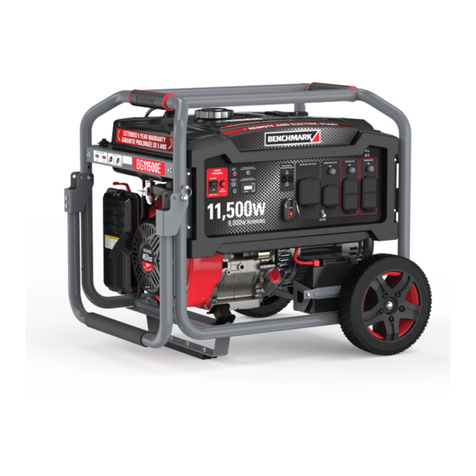
Benchmark
Benchmark BG Series user guide
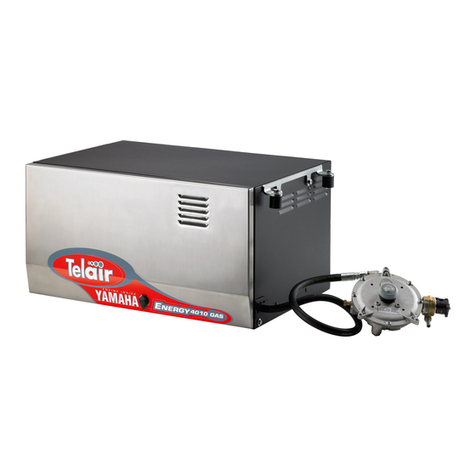
Telair
Telair Energy 4010G Manual for installation and user manual

Generac Power Systems
Generac Power Systems 1576-0 owner's manual
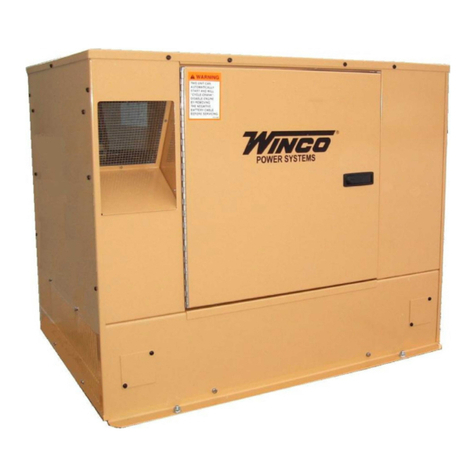
Winco
Winco PSS12H2W/E Installation and operator's manual
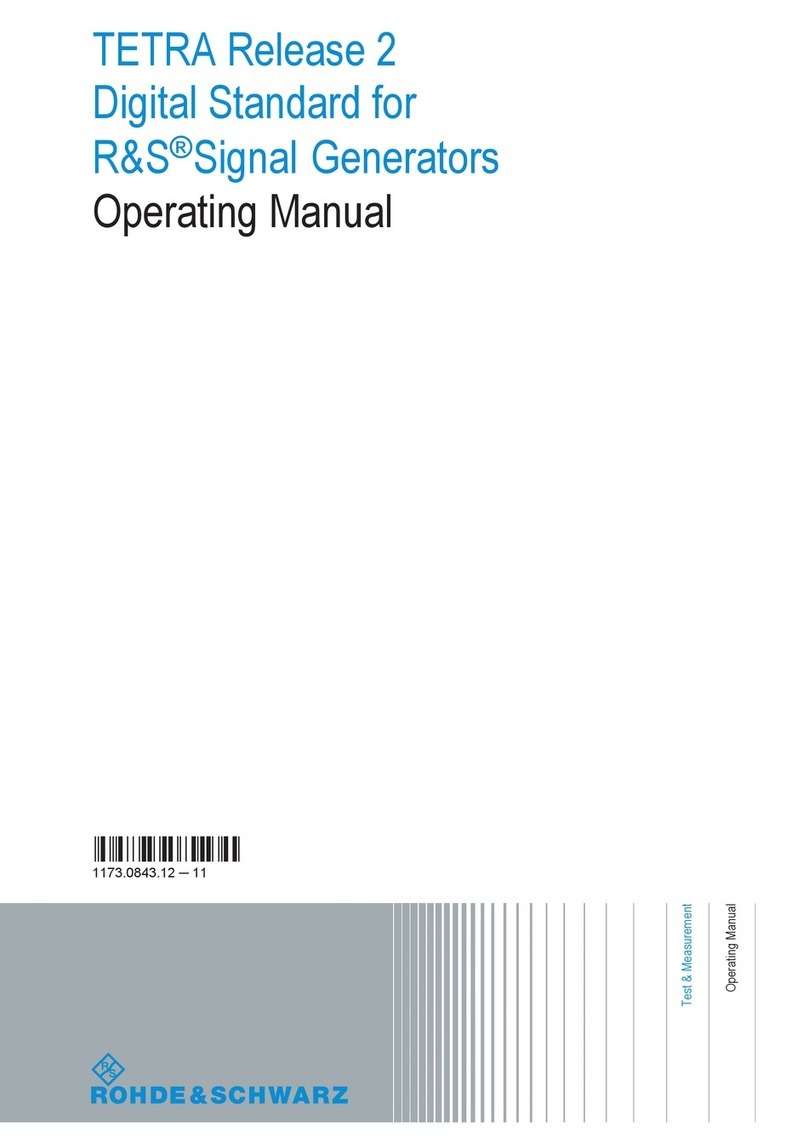
Rohde & Schwarz
Rohde & Schwarz TETRA Release 2 operating manual
